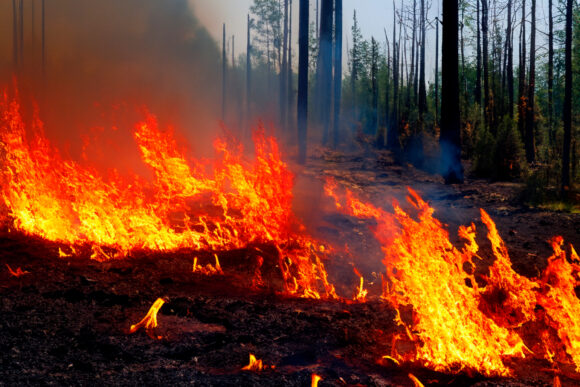Authorities in Western states warned of the rising risk of wildfires as hot conditions and low humidity dry out the landscape amid a protracted heat wave that is expected to bake much of the U.S. again Thursday.
California’s top fire official said Wednesday that so far this year the state has responded to more than 3,500 wildfires that have scorched nearly 325 square miles of vegetation — five times the average burned through July 10 in each of the past five years.
“We are not just in a fire season, but we are in a fire year,” Joe Tyler, director of the California Department of Forestry and Fire Protection, said at a news conference. “Our winds and the recent heat wave have exacerbated the issue, consuming thousands of acres. So we need to be extra cautious.”
California crews working in scorching temperatures and single-digit humidity were battling at least 19 major wildfires Wednesday, including a stubborn 45-square-mile blaze that prompted evacuation orders for about 200 homes in the mountains of Santa Barbara County northwest of Los Angeles. Flames made fuel of tinder-dry brush and grass.
Several wildfires were also burning in Oregon, including one about 111 miles east of Portland that blew up to 11 square miles Wednesday due to hot temperatures, gusty winds and low humidity, according to the state fire marshal.
Oregon Gov. Tina Kotek issued an emergency authorization allowing additional resources to be deployed against fires breaking out as the state has seen record daily high temperatures. Portland reached 103 F (39.4 C) and Salem and Eugene hit 105 F (40.5 C) on Tuesday. The number of potentially heat-related deaths in Oregon rose to 10, according to the state medical examiner’s office.
More than 142 million people around the U.S. were under heat alerts Wednesday, especially in Western states, where dozens of locations tied or broke heat records over the weekend and were expected to keep doing so all week.
Las Vegas on Wednesday recorded its record fifth consecutive day of temperatures sizzling at 115 F (46.1 C) or greater. The temperature climbed to 115 shortly after 1 p.m. at Harry Reid International Airport, breaking the old mark of four consecutive days set in July 2005. And the record could be extended, or even doubled, by the weekend.
Already Nevada’s largest city has broken 16 heat records since June 1 “and we’re not even halfway through July yet,” National Weather Service meteorologist Morgan Stessman said Wednesday. That includes an all-time high of 120 F (48.8 C) set on Sunday, which beat the previous 117 F (47.2 C) record.
In Henderson, Nevada, more than a dozen officers from the Office of Public Response drove around Wednesday offering cold water, bus passes and rides to cooling stations to homeless people and anyone else in need.
On the other side of the nation, the weather service warned of major-to-extreme heat risk over portions of the East Coast. An excessive heat warning remained in place Wednesday for the Philadelphia area, northern Delaware and nearly all of New Jersey. Temperatures were around 90 F (32.2 C) for most of the region, and forecasters warned the heat index could soar as high as 108 F (42.2 C).
In the West, heat was blamed for a motorcyclist’s death over the weekend in California’s Death Valley National Park. At the Grand Canyon, the National Park Service was investigating the death of a third hiker in recent weeks. Temperatures on parts of some trails can reach 120 F (48.8 C) in the shade.
Arizona authorities were investigating the death of a 2-year-old who was left alone in a hot vehicle Tuesday afternoon in Marana, near Tucson, police said. At Lake Havasu, a 4-month-old died from heat-related complications Friday, the Mohave County Sheriff’s Department said.
The U.S. heat wave came as the global temperature in June was a record warm for the 13th straight month and marked the 12th straight month that the world was 1.5 degrees Celsius (2.7 degrees Fahrenheit) warmer than pre-industrial times, the European climate service Copernicus said. Most of this heat, trapped by human-caused climate change, is from long-term warming from greenhouse gases emitted by the burning of coal, oil and natural gas, scientists say.
“Climate change is real,” California Gov. Gavin Newsom said at a news conference Wednesday. “Those extremes are here present every day in the great state of California. If you don’t believe in science, you have to believe your own eyes the lived experience all of us have out here in the western United States, for that matter, all around the globe.”
Newsom said the state was prepared to fight the conflagrations, praising federal support in providing new fire suppression planes to the state. Cal Fire also has been using cameras and artificial intelligence to spot fires and alert first responders, officials said.
In southern New Mexico, heavy rain produced flash flooding on top of wildfire burn scars for the second day in a row on Wednesday, forcing an estimated 1,000 residents to flee their homes in Ruidoso, city spokeswoman Kerry Gladden said.
She said emergency responders had conducted more than 30 water rescues but there were no immediate reports of deaths or serious injuries. She said most bridges over rivers and streams were closed, as was U.S. Highway 70 — one of the main arteries into town — while crews removed debris.
Associated Press journalists Ken Ritter, Rio Yamat and Ty ONeil in Las Vegas; Tran Nguyen in Sacramento, California; Anita Snow in Phoenix; Scott Sonner in Reno, Nevada; John Antczak in Los Angeles; Martha Bellisle in Seattle; and Bruce Shipkowski in Toms River, New Jersey, contributed to this report.
Was this article valuable?
Here are more articles you may enjoy.



 Hurricane Beryl Triggers Record Payout for Caribbean Insurer
Hurricane Beryl Triggers Record Payout for Caribbean Insurer  Woman Used Photos from Another Person in State Farm Claim, NCDOI Says
Woman Used Photos from Another Person in State Farm Claim, NCDOI Says  AT&T Says Data From Around 109M Customer Accounts Illegally Downloaded
AT&T Says Data From Around 109M Customer Accounts Illegally Downloaded  Progressive to Pay $48M to New York Drivers Over Underpaid Total Loss Claims
Progressive to Pay $48M to New York Drivers Over Underpaid Total Loss Claims 

